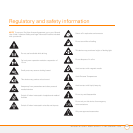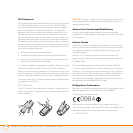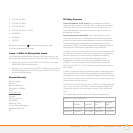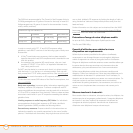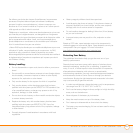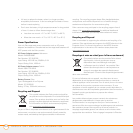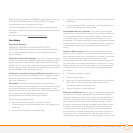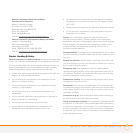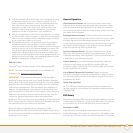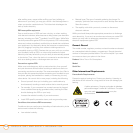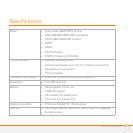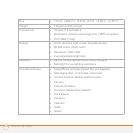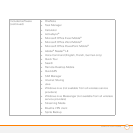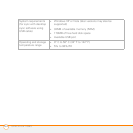
REGULATORY AND SAFETY INFORMATION
355
National Institute on Deafness and Other
Communication Disorders
National Institutes of Health
31 Center Drive, MSC 2320
Bethesda, MD USA 20892-2320
Voice: (301) 496-7243
Email: nidcdinfo@nih.gov
Internet: http://www.nidcd.nih.gov/health/hearing
National Institute for Occupational Safety and Health
Hubert H. Humphrey Bldg.
200 Independence Ave., SW
Washington, DC 20201
Voice: 1-800-35-NIOSH (1-800-356-4674)
Internet: http://wwwcdc gov/niosh/topics/noise
Product Handling & Safety
General statement on handling and use: You alone are responsible
for how you use your smartphone and any consequences of its use.
You must always switch off your smartphone wherever the use of a
phone is prohibited. Use of your smartphone is subject to safety
measures designed to protect users and their environment.
• Always treat your smartphone and its accessories with care and
keep it in a clean and dust-free place.
• Do not expose your smartphone or its accessories to open
flames or lit tobacco products.
• Do not expose your smartphone or its accessories to liquid,
moisture, or high humidity.
• Do not drop, throw, or try to bend your smartphone or its
accessories.
• Do not use harsh chemicals, cleaning solvents, or aerosols to
clean the device or its accessories.
• Do not paint your smartphone or its accessories.
• Do not attempt to disassemble your smartphone or its
accessories; only authorised personnel must do so.
• Do not expose your smartphone or its accessories to extreme
temperatures, minimum 0 and maximum +45 degrees Celsius.
(32F–113F)
• Please check local regulations for disposal of electronic products.
• Do not carry your smartphone in your back pocket as it could
break when you sit down.
Battery: Your smartphone includes an internal lithium-ion or
lithium-ion polymer battery. Please note that use of certain data
applications can result in heavy battery use and may require frequent
battery charging. Any disposal of the smartphone or battery must
comply with laws and regulations pertaining to lithium-ion or
lithium-ion polymer batteries.
Demagnetisation: To avoid the risk of demagnetisation, do not allow
electronic devices or magnetic media close to your smartphone for a
long time.
Normal use position: When making or receiving a phone call, hold
your smartphone to your ear, with the bottom towards your mouth or
as you would a fixed line phone.
Emergency calls: This smartphone, like any wireless phone,
operates using radio signals, which cannot guarantee connection in
all conditions. Therefore, you must never rely solely on any wireless
phone for emergency communications.
Smartphone heating: Your smartphone may become warm during
charging and during normal use.
Accessories: Use only approved accessories. Do not connect with
incompatible products or accessories. Take care not to touch or allow
metal objects, such as coins or key rings, to contact or short-circuit
the battery terminals.
Connection to a car: Seek professional advice when connecting a
phone interface to the vehicle electrical system.
Faulty and damaged products: Do not attempt to disassemble the
smartphone or its accessory. Only qualified personnel must service
or repair the smartphone or its accessory. If your smartphone or its
accessory has been submerged in water, punctured, or subjected to
a severe fall, do not use it until you have taken it to be checked at an
authorised service centre.



